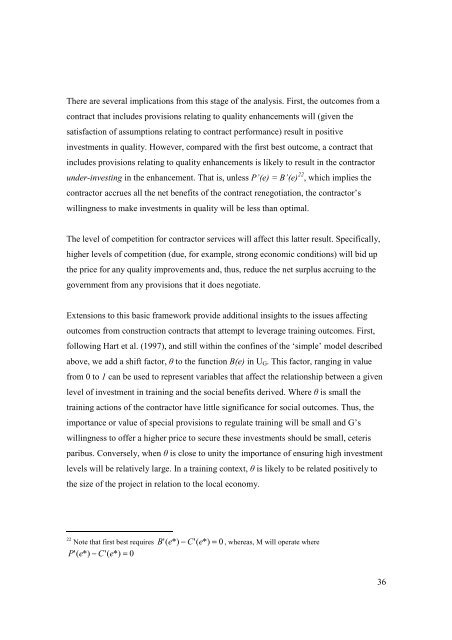Multi Outcome Construction Policy (final report)
Multi Outcome Construction Policy (final report)
Multi Outcome Construction Policy (final report)
Create successful ePaper yourself
Turn your PDF publications into a flip-book with our unique Google optimized e-Paper software.
There are several implications from this stage of the analysis. First, the outcomes from acontract that includes provisions relating to quality enhancements will (given thesatisfaction of assumptions relating to contract performance) result in positiveinvestments in quality. However, compared with the first best outcome, a contract thatincludes provisions relating to quality enhancements is likely to result in the contractorunder-investing in the enhancement. That is, unless P’(e) = B’(e) 22 , which implies thecontractor accrues all the net benefits of the contract renegotiation, the contractor’swillingness to make investments in quality will be less than optimal.The level of competition for contractor services will affect this latter result. Specifically,higher levels of competition (due, for example, strong economic conditions) will bid upthe price for any quality improvements and, thus, reduce the net surplus accruing to thegovernment from any provisions that it does negotiate.Extensions to this basic framework provide additional insights to the issues affectingoutcomes from construction contracts that attempt to leverage training outcomes. First,following Hart et al. (1997), and still within the confines of the ‘simple’ model describedabove, we add a shift factor, θ to the function B(e) in U G . This factor, ranging in valuefrom 0 to 1 can be used to represent variables that affect the relationship between a givenlevel of investment in training and the social benefits derived. Where θ is small thetraining actions of the contractor have little significance for social outcomes. Thus, theimportance or value of special provisions to regulate training will be small and G’swillingness to offer a higher price to secure these investments should be small, ceterisparibus. Conversely, when θ is close to unity the importance of ensuring high investmentlevels will be relatively large. In a training context, θ is likely to be related positively tothe size of the project in relation to the local economy.22 Note that first best requires B '(e*)− C'(e*)= 0 , whereas, M will operate whereP '(e*)− C'(e*)= 036
















